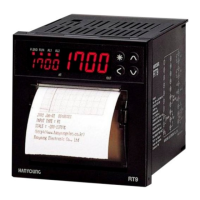
Do you have a question about the Hanyoung RT9 and is the answer not in the manual?
| Brand | Hanyoung |
|---|---|
| Model | RT9 |
| Category | Controller |
| Language | English |
Use external protection circuits, install power switch/fuse, and avoid combustible gas atmospheres.
Use rated voltage, complete wiring before power-on, and avoid disassembling the unit.
Turn off power for maintenance. Avoid installation in extreme environmental conditions.
Details on indoor use, altitude, voltage fluctuations, installation categories, and pollution degree.
Use compensating/shielded cables, separate wires, and noise filters for input signals.
Advice on using extra relays, SSR output, and contact output life for load circuits.
Check alarm function, note error codes, and follow sensor replacement procedures.
Use neutral detergent for cleaning and follow other general precautions.
Describes instrument display, FND segments, and key features like P.I.D, Auto-tuning, and alarms.
Details model designations, suffix codes for configurations, and control output options.
Details input types (Thermocouple, R.T.D, Voltage, Current), sampling time, impedance, and tolerance.
Details specifications for Relay, SSR drive, and Current outputs, including capacity and operation.
Specifies contact capacity and output points for alarm relay outputs.
Details input correction, scaling, P.I.D settings, auto-tuning, fuzzy logic, and ramp function.
Describes alarm types, setting ranges, and recording functions like speed and paper.
Specifies vibration, shock, panel cutout, ambient temp/humidity, and warm-up time.
Details the impact of ambient temperature on input and output accuracy.
Specifies storage temperature range (-25 to 70 °C) and humidity (5-95% RH).
Provides details on the RT9 model, its external dimensions (96x96x100mm), weight, and material.
Details power supply voltage, frequency, consumption, insulation, and dielectric strength.
Indicates safety and EMC standards compliance status.
Covers RS485/RS422 interface, address, method, speed, distance, and response time.
Lists thermocouple and R.T.D. types, codes, ranges, accuracy, and remarks.
Covers direct voltage and current input signals, including types, ranges, and accuracy.
Shows external dimensions and panel cutout size for the RT9 unit.
Diagram and table showing terminal numbers and their functions for connections.
Identifies and explains the function of front panel displays (P.END, RUN, AL1, AL2, SV, PV, AT, OUT).
Explains the function of control keys (Mode, Increase, Decrease, Select Digit) on the front panel.
Illustrates operation display status and shows the menu screen structure for setting items.
Defines the parameter structure for Recorder-only models, including group configurations.
Details settings for group control (mode, zone) and alarm groups (type, dead band).
Covers communication, input, and output settings including mode, type, range, and limits.
Defines settings for time groups, including year, month, day, hour, minute, and second.
Explains how to shift between parameter settings and enter group control.
Details how to operate recorder functions: RUN, Stop, Print selection, and Feed paper.
Allows dividing display levels into 3 stages for restricting operator access.
Provides details on control group settings like mode, zone selection, fuzzy function, and time unit.
Describes STD and Low PV auto-tuning types and auto-tuning start/stop options.
Details P.I.D group parameters like Anti Reset Wind-up, Proportional band, Integral time, and Derivative time.
Allows setting alarm mode, dead band, and values for two alarm outputs.
Details alarm types 1 through 8, including High/Low absolute and deviation values.
Details alarm types 9 through 20, including hold functions and band types.
Configures communication mode, protocol, rate, parity, stop bit, and data length.
Sets device address and response time for communication interface.
Selects output type, mode, sets cycle time, and hysteresis for output control.
Configures maximum and minimum output volume limits when input is disconnected.
Selects input type, mode, range, limits, and decimal point for voltage inputs.
Configures PV filter, PV bias for adjustment, and the burn-out function.
Configures PV filter for noise suppression and PV bias for value adjustment.
Sets the year, month, day, hour, minute, and second for time group settings.
Automatically measures and computes optimum P.I.D values, with Standard and Low PV types.
Sets rate of change for temperature and time for gradual set value adjustments.
Allows zooming in on temperature readings for detailed observation.
Zone PID automatically sets P.I.D group values by recognizing mid-value of reference point.